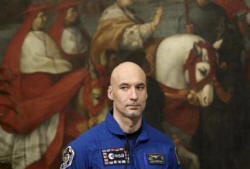|
 NASA
oversight led to spacewalker's near drowning, panel finds NASA
oversight led to spacewalker's near drowning, panel finds
 Send a link to a friend
Send a link to a friend
[February 27, 2014]
By Irene Klotz
CAPE CANAVERAL, Florida (Reuters) - A
panel investigating an astronaut's near drowning during a spacewalk
outside the International Space Station in July found that his spacesuit
leaked during an earlier outing, officials said on Wednesday.
|
|
 NASA misdiagnosed the earlier leak, believing the water found in
the helmet of Italian astronaut Luca Parmitano on July 9 was due to
a ruptured drink bag, said space station chief engineer Chris
Hansen, who chaired an investigation panel appointed by the U.S.
space agency. NASA misdiagnosed the earlier leak, believing the water found in
the helmet of Italian astronaut Luca Parmitano on July 9 was due to
a ruptured drink bag, said space station chief engineer Chris
Hansen, who chaired an investigation panel appointed by the U.S.
space agency.
"Had the issue been discussed in more detail ... the team likely
would have realized that the water experienced in (Parmitano's)
helmet was 'out of family' and needed to be investigated further,"
Hansen wrote in a report released on Wednesday.
Instead, a week later on July 16, Parmitano and NASA astronaut Chris
Cassidy put on their spacesuits to continue work outside the space
station, a $100 billion research complex that flies about 260 miles
above Earth.
About 45 minutes into the spacewalk, Parmitano radioed to ground
controllers that water was leaking into his helmet.

Investigators said NASA did not immediately recognize the
possibility that Parmitano's suit was failing.
Engineers mistakenly believed a water leak would trip a fan to shut
down, signaling a suit problem. Instead, the fan remained
operational despite water seeping its way around a valve and
ultimately inside the spacewalker's helmet.
By the time flight controllers aborted the spacewalk, water obscured
Parmitano's vision and impaired his breathing. As the astronaut made
his way into the airlock, assisted by Cassidy, he lost radio
communications as well.
About 1.5 liters (3.17 pints) of water ended up inside Parmitano's
helmet, or about twice as much as what was found after the July 9
spacewalk, the report shows.
Initially, no one suspected that first leak was anything more
serious than a burst drink bag.
"This was a really subtle problem. It took us weeks before we
started getting to the conclusion that this had happened earlier,"
Hansen told reporters on a conference call.
[to top of second column] |

Ultimately, engineers figured out that the leak was due to
contamination in a pump that is part of the spacesuit's cooling
system. The source of the contamination remains under investigation.
The 220-page report includes 49 recommendations to beef up safety
protocols, training and communication. NASA says it will implement
the findings before scheduling its next series of spacewalks,
targeted for this summer.
NASA has twice before been surprised by unknown technical
implications of hardware problems, with disastrous results. In 2003,
foam insulation falling off the space shuttle's fuel tank during
launch caused wing damage that destroyed the Columbia as it glided
through the atmosphere for landing, killing seven astronauts.
The 1986 Challenger accident, which also killed seven astronauts,
was later blamed on a booster rocket seal that failed during its
launch in cold weather.
"The message to all of us is to be really vigilant and to really
communicate," said NASA spaceflight chief William Gerstenmaier.
"We're not hiding this stuff. We're actually out trying to describe
these things, describe where we can get better. I think that's how
we prevent Columbias and Challengers," he said.
(Editing by David Adams and G Crosse)
[© 2014 Thomson Reuters. All rights
reserved.] Copyright 2014 Reuters. All rights reserved. This material may not be published,
broadcast, rewritten or redistributed.

 |